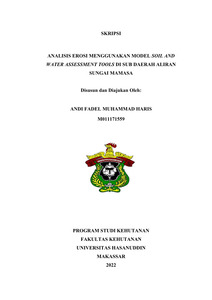Haris, Andi Fadel Muhammad (2022) ANALISIS EROSI MENGGUNAKAN MODEL SOIL AND WATER ASSESSMENT TOOLS DI SUB DAERAH ALIRAN SUNGAI MAMASA = EROSION ANALYSIS USING SOIL AND WATER ASSESSMENT TOOLS MODEL IN THE MAMASA RIVER FLOW REGION. Skripsi thesis, Universitas Hasanuddin.
![[thumbnail of Cover]](/17961/1.hassmallThumbnailVersion/M011171559_skripsi_20-07-2022%20cover1.png)

M011171559_skripsi_20-07-2022 cover1.png
Download (130kB) | Preview
M011171559_skripsi_20-07-2022 1-2.pdf
Download (370kB)
M011171559_skripsi_20-07-2022 dp.pdf
Download (1MB)
M011171559_skripsi_20-07-2022.pdf
Restricted to Repository staff only
Download (1MB)
Abstract (Abstrak)
Based on data released by BPDASHL Saddang Saddang in 2018 erosion in the Mamasa sub-watershed reached 62.9 tons/ha/year. Sub watershed Mamasa, SADDANG watershed is very important for Bakaru dam, PLN hydroelectric power station, as well as other local hydroelectric power station located downstream of Mamasa watershed, SADDANG watershed. This study aims to analyze the erosion of sub-watershed Mamasa. The usefulness of the results of this study is as a reference in watershed management planning, either in the form of rehabilitation programs, watershed characteristics, or other programs as well as government considerations to overcome the problem of drought in sub watershed Mamasa. The study was conducted for three months in Mamasa sub-watershed, SADDANG Watershed through several stages, namely data preparation, erosion analysis with SWAT model and data analysis. Analysis of the impact of land cover change on river discharge value using SWAT model simulation. SWAT requires data input in the form of land cover map, soil type map, slope map, and climate data. SWAT simulation was conducted from 2011 to 2020. The results of hydrological simulation conditions in general can be seen in the run SWAT Check feature in the Read SWAT output window. Figure 5 shows a picture of hydrological processes in sub-watershed Mamasa as follows: 1) total rainfall 2389.8 mm,4.005% into surface flow. 2) 63.23% of rainwater was infiltrated (7.74% percolated and 55.5% into lateral flow) and 3) 32.63% of total rainwater was vaporized. Based on the results of research that has been done can be concluded that the average very light erosion is in secondary dryland forest with an area of 31,591.17 (30.14%). with an erosion value of 3.68 tons/ha/year, while very heavy erosion is in shrubs with an area of 2,795.04 Ha (2.67%) with an erosion value of 7,423. 94 tons/ha/year.Keywords: Landcover; River Discharge; SWAT; Coefficient of River Regime; Mamasa sub-watershed.
Keywords : Soil; Forests; Droughts.
| Item Type: | Thesis (Skripsi) |
|---|---|
| Subjects: | S Agriculture > SD Forestry |
| Divisions (Program Studi): | Fakultas Kehutanan > Kehutanan |
| Depositing User: | S.Sos Rasman - |
| Date Deposited: | 15 Aug 2022 02:41 |
| Last Modified: | 15 Aug 2022 02:41 |
| URI: | http://repository.unhas.ac.id:443/id/eprint/17961 |


